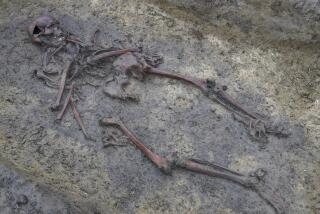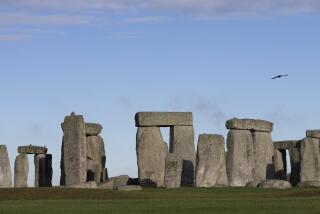Human remains buried at Stonehenge 5,000 years ago offer a clue to where they came from
- Share via
At least some of the people who were buried at Stonehenge died and were cremated far from the site — probably in west Wales about 120 miles away, according to a new study.
The finding, published Thursday in Scientific Reports, provides another small clue to understanding who was buried at the prehistoric monument around 3000 BC, and how they came to be there.
For the record:
10:00 a.m. Aug. 3, 2018The headline on an earlier version of this article stated that the people at Stonehenge were buried 3,000 years ago. They were buried 5,000 years ago.
The cremated remains of more than 50 individuals were first excavated from Stonehenge in the 1920s. They were discovered in a series of 56 pits known as Aubrey Holes in the inner circumference of the monument.
Because the remains of these ancient people had obviously been cremated before they were buried, archaeologists at the time decided to dump them all back into one hole — Aubrey Hole 7.
“Cremated remains did not have much value in the 1920s,” said Christophe Snoeck, a post-doctoral researcher in geochemistry and archaeology at Vrige University of Brussels in Belgium. “Unfortunately, all the remains were simply re-buried.”
What these 20th century researchers couldn’t know is that nearly 100 years later Snoeck would discover that these burned bones could still talk.
In 2015, Snoeck showed it was possible to use a process called strontium isotope analysis even on bones that had been heated up to 1,800 degrees Fahrenheit.
“Strontium isotope analysis has been used for decades to reveal the mobility of human and fauna, but exclusively on unburned material,” he said. “I demonstrated that cremated bone fragments could also be used in such studies, opening the possibility to study many more sites, including Stonehenge.”
Different types of bedrock display different ratios of two strontium isotopes — strontium-87 and strontium-86. Plants absorb strontium as they grow, and as people eat those plants the strontium passes into their bones and teeth.
By creating a map of strontium isotope ratios across a geographical area and comparing that with those found in a bone fragment, scientists can determine a human or animal’s place of origin — or at least where they spent the majority of the last 10 years before they died.
In this study, the researchers identified bone fragments belonging to 25 distinct individuals that had been buried at Stonehenge. The strontium isotope analysis revealed that the bones of 15 of these people exhibited the same strontium isotope ratio that existed in the area around the monument.
The results from the other 10, however, showed that these people did not consume food grown in the local area alone.
Snoeck said the results were unexpected.
“We expected to see some people that were not local, but so many was a surprise,” he said.
The researchers can’t be totally sure where these 10 people came from, but the strontium isotope ratios in their bones are consistent with a region in west Wales that is known to be the source of some of the stones in the monument.
Further analysis also suggested that the wood fuel that was used to cremate some of these people did not come from the area around the monument either.
One possible interpretation of these findings is that a group of humans transported stones from west Wales to Stonehenge along with the cremated remains of their dead.
When they raised the stones at Stonehenge, perhaps they buried their dead at the same time, the authors wrote.
Do you love science? I do! Follow me @DeborahNetburn and “like” Los Angeles Times Science & Health on Facebook.
MORE IN SCIENCE







